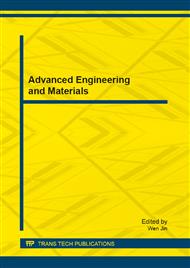[1]
H. Xie, G. Fedder, Vertical comb-finger capacitive actuation and sensing for coms-MEMS, Sensors Actuators A 95, 212 (2002).
DOI: 10.1016/s0924-4247(01)00740-3
Google Scholar
[2]
M. I. Younis, A. H. Nayfeh, A study of the nonlinear response of a resonant microbeam to an electric actuation, Nonlinear Dyn. 31, 91 (2003).
Google Scholar
[3]
S. Liu, A. Davidson, Q. Lin, Simulation studies on nonlinear dynamics and chaos in a MEMS cantilever control system, J. Micromechan Microeng 14, 1064 (2004).
DOI: 10.1088/0960-1317/14/7/029
Google Scholar
[4]
H. S. Haghighi, A. H. D. Markazi, Chaos prediction and control in MEMS resonators, Commun. Nonlinear Sci. Numer. Simul. 15, 3091 (2010).
DOI: 10.1016/j.cnsns.2009.10.002
Google Scholar
[5]
M. M. Siewe, U. H. Hegazy, Homoclinic bifurcation and chaos control in MEMS resonators, Applied Mathematical Modeling 35, 5533 (2011).
DOI: 10.1016/j.apm.2011.05.021
Google Scholar
[6]
A. Luo, F.Y. Wang, Chaotic motion in a micro-electro-mechanical system with non-linearity from capacitors, Commun. Nonlinear Sci. Numer. Simul. 7, 31 (2002).
DOI: 10.1016/s1007-5704(02)00005-9
Google Scholar
[7]
F. R. Chavarette, J. M. Balthazar, J. L. P. Felix, M. Rafikov, A reducing of a chaotic movement to a periodic orbit of a micro-electro-mechanical system by using an optimal linear control design, Commun. Nonlinear Sci. Numer. Simul. 14, 1844 (2009).
DOI: 10.1016/j.cnsns.2008.09.003
Google Scholar
[8]
E. Barry, M. De, E. Butterfield, J. Moehlis, K. Turner, Complex nonlinear oscillations in electrostatically actuated microstructures, J. Microelectromech. Syst. 16, 1314 (2007).
Google Scholar
[9]
H. T. Yau, C. C. Wang, C. T. Hsieh, C. C. Cho, Nonlinear analysis and control of the uncertain micro-electro-mechanical system by using a fuzzy sliding mode control design, Computer and Mathematics with Appliction, 61, 1912 (2011).
DOI: 10.1016/j.camwa.2010.07.019
Google Scholar
[10]
V. I. Utkin, Sliding Modes in Control and Optimization, Springer-Verlag, Berlin (1992).
Google Scholar
[11]
Y. Feng, X. Yu, Z. Man, Non-singular terminal sliding mode control of rigid manipulators, Automatica 38, 2159 (2002).
DOI: 10.1016/s0005-1098(02)00147-4
Google Scholar


